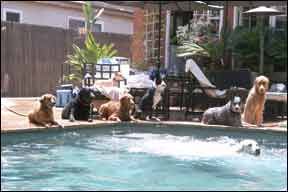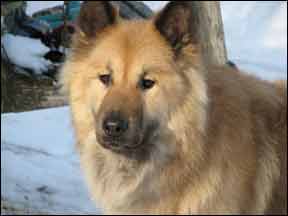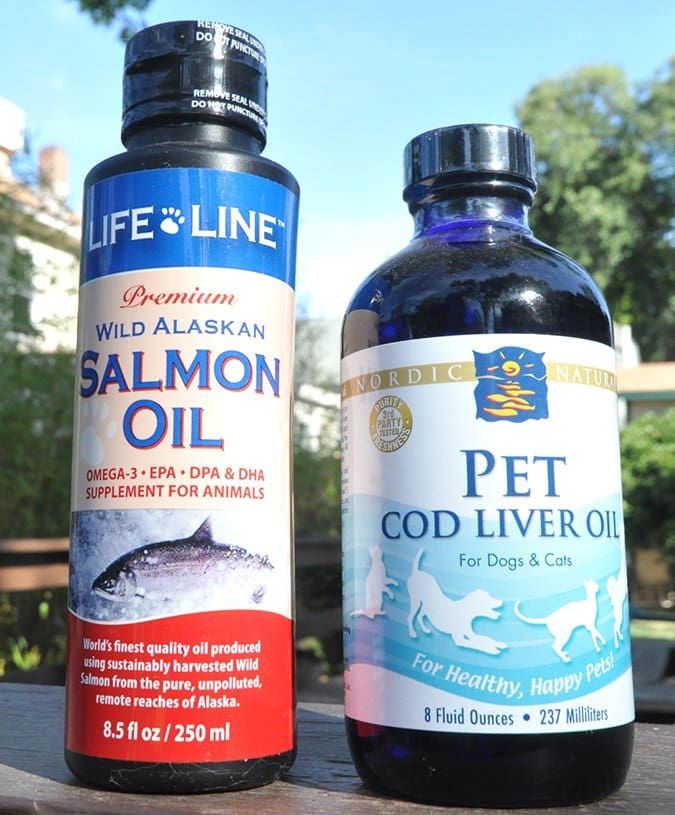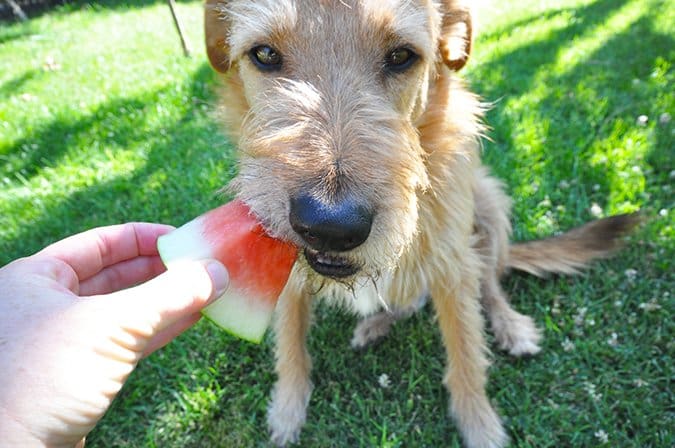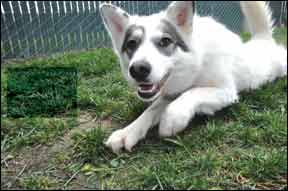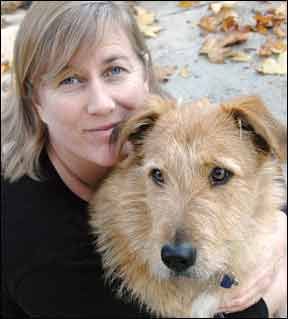POOL SAFETY OVERVIEW
What you can do…
– Teach your dog a proper swimming technique and make sure he knows how to safely exit the backyard pool.
– Learn the signs of heatstroke, which can occur even when enjoying water play.
– Have an emergency plan, which includes knowing the location of the nearest emergency vet and CPR for pets (and people).
Imagine this: A hot summer day, blue skies, a beautiful lake, and a bunch of friends tossing toys into the water for their dogs to fetch. One gorgeous, healthy Labrador swimming strongly to retrieve a toy that has sailed out beyond the rest. Cue some ominous music as you notice that the dog, who is powering through the water like she is driving toward an amateur field champion win at a hunt test, already has a toy in her mouth. As she reaches the second toy, a large ball with an unusual shape, she confidently bites toward it for the retrieve. But with one toy already in her mouth, she can’t quite get hold of the second object, so she diligently powers on, heading farther and farther into the lake with each failed attempt to grasp the toy, even as her owner repeatedly calls her name and uses her recall cue.

This scene actually played out in front of me at an annual retreat that I organize as a dog trainer. That’s why, when I realized what was happening, I was as horrified as the dog’s owner, Elisa Becker of Malibu, California. “I thought she would hear her recall word and turn around,” says Becker. Her dog Julia, a six-year-old Labrador, was obsessed with retrieving. This is ordinarily a good thing, but in this case, Julia’s passion was taking her farther and farther out into the water. I knew Julia was a strong swimmer, but I also worried that, given her persistence, she might exhaust herself. Plus, she was heading far enough out to get in the way of the miscellaneous watercraft on the lake.
“I started to panic as she was getting farther and farther out,” says Becker. “I just kept thinking, ‘Turn around! Turn around!’ Then I thought, ‘What am I going to do when she swims across the lake?’ and I remember feeling myself starting to hyperventilate, and thinking I needed to take deep breaths or I wouldn’t be able to swim; and I’m not a strong swimmer, so that was concerning me.”
I stripped my pockets of electronics and started swimming toward Julia. I knew I’d never catch up to her if she kept going, but my plan was to splash around and become interesting enough to break her fixation with the second toy.
The plan worked fairly quickly. She turned around so she could see what all the splashing was about, and then finally “heard” Becker calling, and swam right past me on her way to shore, preparing herself for the next retrieve.
“When she finally turned around and swam past you to come back in, I remember thinking that she had no idea of the danger she was in,” Becker says. “She dropped the toy and acted like she wanted to go back in, and I knew we were the only ones who were ever worried. She never panicked and didn’t seem tired.”
Dogs Do Drown
Fortunately, all we lost that day was the one toy. Not all owners are as lucky. Many dogs do drown, especially when the summer sun finds dogs of all shapes and sizes in contact with backyard pools, beaches, lakes, stock ponds, and neighborhood swimming holes. Water fun can be a great way for pets and people to play together and cool off, but just as specific safety precautions must be followed when children are near water, similar precautions exist for pets.
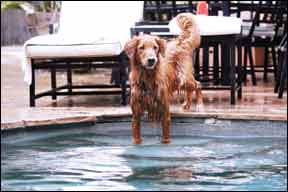
Drowning ranks fifth among leading causes of unintentional injury and death to humans in the United States. Every day, according to Centers for Disease Control and Prevention, about 10 people die from unintentional drowning. There isn’t an equivalent government agency to compile statistics for dogs, but various groups have collected some relevant data:
One pet products company estimates that the odds of a pet drowning are 1 in 1,028.
Jules Benson, DVM, vice president of veterinary services with Petplan Pet Insurance, reports that about 1 of every 34,000 submitted insurance claims are related to drowning or near-drowning.
Cynthia Jones, DVM, a shelter veterinarian for the Humane Society of North Texas in Fort Worth, reports dealing with two to three water-related pet fatalities, and lots of water-related injuries, every summer in her former career as a private practice veterinarian.
Even pool maintenance professionals have stories of entering clients’ homes, only to discover a dog clinging to life on the edge of the pool – or worse.
Swim Lessons for Dogs
Many dogs benefit from a swimming lesson or two. A common misconception is that all dogs can “dog paddle” and keep themselves afloat in the water. Inexperienced (or panicked) swimmers often concentrate their efforts on the front legs, forgetting to fire up the back end. Front-end-only swimming is rather ineffective and uses a tremendous amount of energy. As a result, dogs end up near-vertical in the water, with lots of splashing.
Getting in the pool with the dog and supporting his back-end as he swims a short distance is often a great way to prompt him to begin effectively using his back legs. Using a dog life jacket to help keep him afloat can help anxious swimmers relax enough to paddle with all four legs. As a dog gets the hang of using his front and back ends in unison, the body evens out and splashing becomes minimal.
The “make and model” of your dog can have a lot to do with how effectively he can handle himself in the water. Breeds with broad chests and shorter legs (Bulldogs, Corgis, Pugs, etc.) aren’t really designed for effective swimming, and heavily muscled breeds (like many of the so-called “bully” breeds) exert a lot of energy in the water due to their greater body mass. Sighthounds (Whippets, Greyhounds, etc.) often have the double disadvantage of heavy muscling plus little body fat to help with buoyancy, especially if they regularly partake in recreational racing and coursing. A well-fitting life jacket helps provide an added layer of safety during water play.
Beware the Heat
Swimming is a great way for dogs to burn off excess energy, stay in shape and even shed some unwanted pounds. When swimming an overweight dog, be sure to check with your veterinarian first and be careful not to overdo it. The more overweight the dog, the more quickly he will tire. Start slowly and gradually increase the amount of time your dog swims. Similarly, when dealing with dogs who lead mostly sedentary lives, avoid the “weekend warrior syndrome” of too much of a good thing. Dogs, like people, experience muscle soreness and stiffness, and they’re counting on us to look out for their best interests. Even dogs who love the water often need to be forced to take a break. Always be on the lookout for signs of fatigue (such as when a dog’s rear end starts to ride lower in the water as he’s swimming) or over-stimulation (in water-loving dogs, this is often a wide-eyed, frenetic pace).
Heat stroke is often a hidden danger that lurks along the sidelines of water play with our pets, especially during summer months.
“The water play keeps the body temperature down unless they’re being exerted at the same time,” says Jones, describing the common scene of a dog running along the shoreline to retrieve. “The dog is running back and forth and getting cooled off when he jumps in the water, but then he’s getting hot because he keeps chasing the stick.”

The water helps lower the dog’s external body temperature, but the activity, especially on hot days, can still drive internal body temperatures to dangerous – even deadly – levels.
“Once a dog starts panting, owners need to look at the gums and tongue color,” explains Jones. “When the dog begins panting and the gums start getting dark pink, you need to stop. Throw the ball four or five times and then bring your dog in and let her rest in the shade and have some water.” (Note: Being able to recognize the dark pink nature of your dog’s tongue and gums requires that you are familiar with the “normal” pink color. Every dog is different. Be sure to learn what’s “normal” for your individual dogs.)
Dr. Benson agrees. “The biggest thing with heat stroke is to be aware that dogs really have no other form of getting rid of heat other than panting,” he says. “Panting causes heat to be lost through the evaporation of saliva in their mouth and on their tongue. My general advice is not to have pets out in direct summer sunlight during the usual times that we’re told not to go out in the sun: after 10 a.m. and before 4 p.m., especially if there’s going to be exercise.”
If your dog does overdo it and is falling victim to heat stroke, signs to watch for, says Benson, include a staggering gait and an overall “drunken” appearance. In that case, it’s time to head to the nearest veterinarian.
“I would always seek vet care for heat stroke,” advises Benson. “The normal body temperature for a dog goes up to about 103 degrees. An internal temperature of 103 to 105 degrees is uncomfortable. Anything above 105 degrees can cause brain damage. You need to get to a vet to make sure everything is okay, and if the temperature is above 105, the vet can give IV fluids and help cool the dog down properly.” While en route, wet towels along the back of the neck, groin and armpit areas (sites of major blood vessels), with a fan blowing over them, is one of the best ways to begin cooling the dog. As with people, avoid the “old wives tale” remedy of total submersion in ice water, as it creates too much shock to the system.
Proper Pool Exits
If the backyard pool is your water spot of choice, there are several important things to consider. It’s imperative that your dog knows how to safely exit the pool. Even accomplished swimmers can drown while trying unsuccessfully to claw their way out from the edge of the pool.
“I think people would be surprised at the number of pets who drown in backyard pools because they fall in and can’t get out,” says Jones, who says obese dogs, geriatric dogs, and small dogs are especially at risk because of the added physical challenges associated with trying to climb out at the edge if not properly trained.
“The biggest problem (seen in her former private practice) was the old dogs who were blind or partially blind. They’d go outside at night to use the bathroom, not see the edge of the pool, fall in, and between it being dark and the dog not having good vision, they’d be gone before you know it.”Whenever possible, veterinarians and trainers alike recommend installing a fence around the pool or, at the very least, training the dog to confidently find and use the steps to safely exit.
“People who have a backyard pool and a dog really need to teach the dog how to go in and out of the pool using the steps,” says Jones. She also recommends marking the stair area with an easy-to-spot visual, such as a large potted plant, to help the dog orient and find the way out, especially if in a panic.
“Put something where the stairs are, so when the dog falls in and he’s scared and turning around trying to figure out which way is out, he just has to spot that one thing to know where the stairs are and be able to find the area of safety,” Jones says.
Proper training is necessary to teach your dog to effectively use the stairs or other pool-exit device, such as a ramp or set of pet stairs. If your dog is a willing swimmer, associating the area with plenty of treats, petting, and praise is a great way to help establish the habit of exiting the pool at specific points. For toy breeds, consider placing a landscaping brick or two on the top pool step to make it a shorter climb out (or in) for your dog. Additionally, teaching your dog to only enter the pool at a specific spot – such as via the steps – not only reinforces its value, but can also prevent the dog from leaping into the pool and landing on unsuspecting swimmers. Also, when you don’t want to the dog to go in the pool at all, using a barrier to block access to the stairs effectively announces to your dogs that the pool is temporarily closed.

Reluctant swimmers require great care and patience when working in and around water. Just because your dog will never voluntarily go for a swim, doesn’t mean he gets to skip the safety lesson.
Marsha Rothpan of West Hills, California, knows all too well what can happen when water-reluctant dogs find themselves on the wrong side of the pool’s edge. Her Labrador Retriever, Max, once took a surprise spill into the backyard pool while absorbed in chasing a squirrel.
“He fell in the deep end and was probably doggie paddling for 10 minutes before I figured out why Stokley, my other dog, kept coming to me and acting strange,” she remembers. “I tried calling him to the stairs, but he went to the side with a freaked-out, panicked look in his eyes. He reminded me of a wild mustang being roped.” In her panic, she managed to haul the then 100-pound dog out of the water. “His nails were gone, his paws were bloody and it was one of the scariest things I’ve ever experienced with a dog.”
The incident prompted her to contact a trainer to come help teach Max to find the stairs. He’s still not a fan of the water, and the Rothpan family now takes the added precaution of keeping an eye on the dogs when they’re outside and closing the dog door when they aren’t home.
When teaching a pet to be safe in the pool, it’s absolutely imperative that you take your time and establish your dog’s trust. Above all else, never throw your dog into the water to let him “figure it out on his own.” Not only can this damage the relationship with your dog, a panicked dog is in survival mode, not learning mode.
For professional trainer Lisa Maldonado of Glendale, Arizona, canine water safety training makes up about 75 percent of her training business.
“The key is to make the pool positive and get your dog on the steps,” says Maldonado. “Work with the dogs. When they’re hot, they’re more likely to want to go into the pool. If they’ve been sleeping all day and their core is cool from being inside with air conditioning, they’re not as likely to want to be in the pool at all.”
Maldonado initially outfits her canine clients in life jackets to help them remain buoyant, which, she says, reduces the chance that the dog goes into survival mode, and helps make him more receptive to learning. Her approach involves physically placing the dog on the steps, while leashed, and patiently encouraging him to venture out and explore the pool. As the dog begins swimming, the leash allows her to redirect the dog back toward the stairs if he tries to climb out along the side. Patience and repetition helps condition the dog to return to the steps, bench, or other “safe” area.
“I find out where his weak spots are in the pool and keep working past those,” she says. “It’s very incremental, but it’s amazing to see when the dog knows how to get out.” Maldonado adds that, whenever possible, it’s best to avoid helping your dog out at the side of the pool because he’ll likely remember that, and you want it to be clear to the dog that the only way out (especially when you’re not there to help) is at the stairs or bench.
Another option I’ve used is to back-chain a safe pool exit by establishing the stairs as the most valuable spot in the pool through a strong reward history, carrying the dog into the water, and having him swim to the steps from different points in the pool.
While some may scoff at the idea of specialty swimming lessons for pets, it’s a valuable skill that can mean the difference between life and death.
“It just takes that one time,” cautions Maldonado. “You would take care of a human child around a pool. We care about our dogs as much as human children. If you have a pool, either train the dog to be safe, or install a fence around the pool. It’s that simple.”
We would add, even if you have a fence, it’s wise to invest in pool safety. “It just takes that one time,” goes for accidentally leaving a pool gate open, too.
Other Safety Tips for Dogs in the Pool
Even when your dog loves the water and has mastered the art of safe entry and exit when poolside, there are several other key points to consider to help ensure safe water play.
Just say ‘No’ to Floating Pool Covers – Floating covers are extremely dangerous in homes with children and pets. Countless dogs, even accomplished swimmers, have lost their lives following an unexpected tumble into a covered pool. Falling underneath or even on top of a floating cover is extremely disorienting and it becomes almost impossible for the dog to find his way out. Invest in a safety cover, which fits over the entire pool and is anchored in place to create a physical barrier between the water and those around the pool.
Unintentional Pawticures – Dogs can quickly wear their nails down to the point of bleeding as they excitedly race around the pool’s exterior. It’s important to keep an eye on the pads of their feet as well. Repeated launching from the pool steps can tear up paw pads, especially on dogs who spend most of their time on grass. Hot concrete, stone decking, and hot or rough rocks along the lake shore can also tear up or severely burn their pads. “Every year I see cases where the pads of the feet are sloughing off because they got burned,” says Jones.
Poolside Patience, Please – It’s also important to teach your dog to remain calm when others are swimming. Many dogs want to excitedly race around the exterior of the pool, barking madly while their favorite humans take a dip. If you don’t want him racing around the pool in bark-fest mode, try not to ever let him practice.
When you want some dog-free pool time, consider confining your dog indoors where he can’t see the pool activity, and give him his favorite chew bone or other consolation prize. Additionally, set up training sessions where one person works the dog (leashed, with wonderful treats in-hand) while another casually enjoys the pool, and reward generously for calm poolside behavior.
Be Aware of Your Surroundings before allowing your dog in the water – Be sure to take note of (and follow!) local regulations which may dictate whether or not dogs can be in the water and if so, if they can be off-leash. Pay attention to hazards below the water’s surface (such as logs or other obstacles), as well as general water conditions, especially potential rip currents, undertow, or deceptively fast-moving water. Keep an eye out for discarded hooks when near a fishing area, and consider adding a pair of wire cutters to your training bag. Speaking of fishing, pay attention to the birds at the seashore. If the birds are fishing, there are bait fish in the area, and bait fish can often mean that bigger fish, even sharks, are nearby.
Don’t Drink the Water – Avoid letting your dog drink excessively from the backyard pool. The same goes for rivers, ponds, lakes, and the ocean. Be sure to always carry plenty of fresh water – more than you think you’ll need – when enjoying outdoor activities. While dogs are certainly more resilient to various bacteria in the environment than their human counterparts, Giardia is not uncommon among dogs who visit ponds and lakes. Leptospirosis is also extremely common in the southwest, and according to Benson, has also recently spread to the Midwest and into the north. For this reason, if your summer plans include travel, it’s always a good idea to speak with your vet about diseases that might be uncommon or non-existent in your area, but prevalent throughout your travel route or at your intended destination.
Post-swim Spa Treatments – Be sure to rinse off your dog following an outdoor water adventure. Chlorine and other pool chemicals can dry out a dog’s coat and skin, and swimming in natural environments can result in a dirty dog. Be mindful of areas that tend to remain damp, such as the ears or area under the collar. Ear infections and hot spots are common in water-loving dogs. To help prevent ear infections, Dr. Benson recommends a post-water ear flush with a commercial ear wash or a mixture of half water, half white vinegar to help dry the ear and create an environment that’s not conducive to yeast overgrowth.
Have a Plan – Accidents happen. Think ahead about what you’d do if you had to rescue a pet from the water. Are you a strong swimmer? Consider bringing a human life jacket so that there’s one less thing to worry about in the heat of the moment. Know the location of the nearest emergency vet, and have a well-stocked pet and human first-aid kit in the car. It’s also a good idea to learn CPR for pets and people.
It’s not pleasant to imagine an emergency spoiling your summer fun, but a little pre-planning and diligent training will keep you and your pets enjoying the water for years to come.
Stephanie Colman is a writer and dog trainer in Los Angeles. She shares her life with two dogs, and actively competes in obedience and agility.


